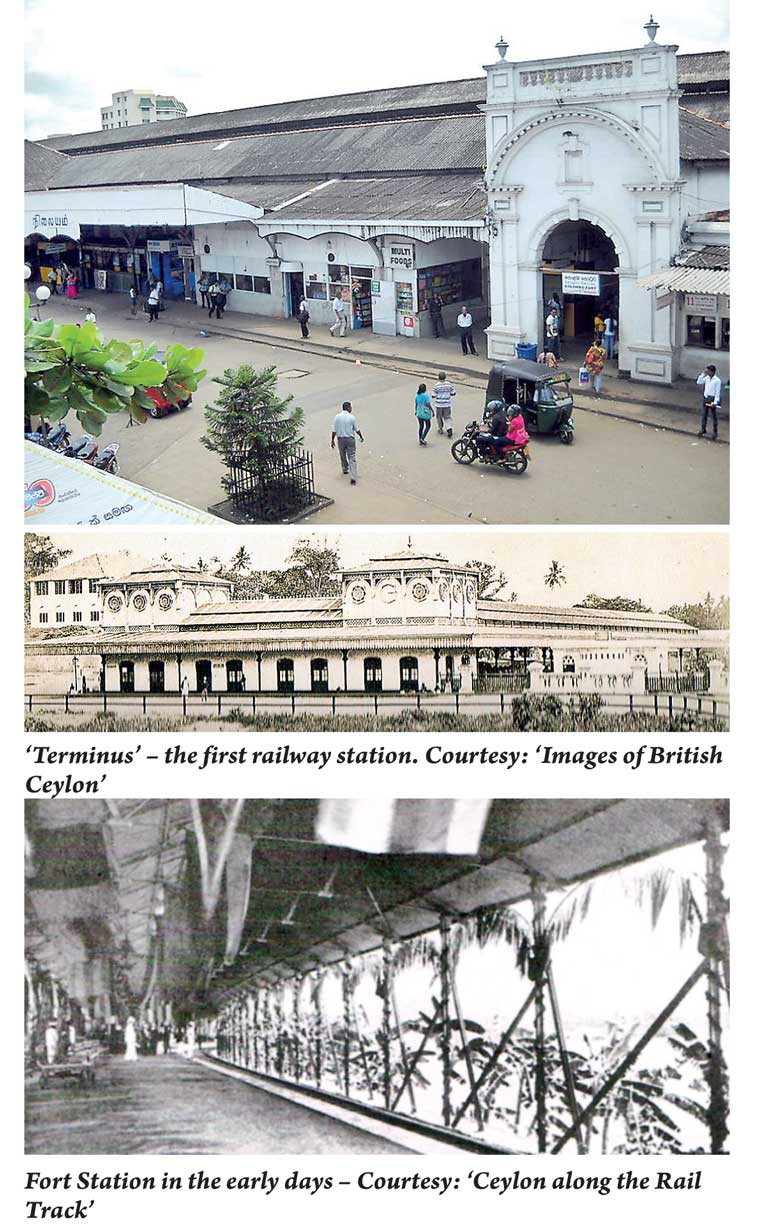Friday Apr 26, 2024
Friday Apr 26, 2024
Saturday, 21 October 2017 00:00 - - {{hitsCtrl.values.hits}}

By D.C. Ranatunge
Colombo Fort Railway Station celebrated its centenary early this month. Ironically the landmark event coincided with a strike by railway employees resulting in a deserted station as compared with the thousands of commuters who fill the platforms every day.
Fort Station is yet another heritage building in Colombo dating back to the British Colonial era in the same vintage as the buildings housing the Secretariat, old Parliament and the Customs, to name a few. It is on record that the building is similar to the Manchester Victoria station in England which was constructed in 1844.
Though Fort station is the major rail hub today, it was not the first station to be opened after Ceylon Government Railway (CGR) was founded in 1858 and started operations in the mid-1860s. Since the start was made with the Main Line – Colombo to Kandy, the first station was the ‘Terminus’ close to Maradana. Initially, the operation was mainly to handle the products brought down from the plantation areas. Gradually the public found it to be a convenient way to travel.
“The growing goods traffic of Colombo necessitated extension of the main goods yard, adjoining the Terminus Station; and after the consideration of schemes for grappling with the problem of increased passenger and goods traffic in an already crowded locality, it was decided to make Maradana Junction the principal passenger station of Colombo and to close the Terminus for passenger traffic, the space thus released being utilised for extension of the goods yards, railway workshops and other improvements,” writes Henry W Cave in ‘Ceylon along the Rail Track’ (1910).

Once the Coast Line began operations in 1887 two stations were established - one in Pettah and the other in Fort. Soon it was decided to amalgamate both stations and build one station. Thus was born the present Fort Station which was built on a block of land reclaimed from the Beira Lake. Though work was completed by 1911, there was a delay in completing the work on the track. Meantime the First World War intervened and the place was used as a food store. Thus the opening of the station was delayed until 1917.
The station was formally opened by Governor John Anderson and the General Manager of Railways, G.P. Grin. The first station master was A.F. Gunawardane. Once it was opened the commuters found it to be very convenient.
“The station is largely used by the clerks of the European mercantile firms and the government offices in the Fort who live in the suburbs and in the more distant towns and villages to the south of Colombo. It is also a most convenient starting point for passengers from the steamships and visitors at the Grand Oriental and Bristol hotels, who take trips to Mount Lavinia and the various places of interest farther south,” Cave wrote.
As more and more offices started opening both in the mercantile sector and the public sector, this trend continued with Fort Station becoming very popular for daily passengers. A further attraction was the season tickets offered by the Railway at concessionary rates. I was a regular train traveller from my school days in the late 1940s/early ‘50s. We got in at Gampaha and got down at Maradana to go to Ananda. When I started working at Lake House in mid-1950s I travelled from Gampaha to Fort. There was a short cut to McCallum Road (later D R Wijewardene Mawatha) from the ‘back door’ where tickets were checked at the gate. Those who had season tickets had no problem. They only had to show them and move on. It was just a hop, step and a jump to Lake House.
The station faced Norris Road (now Olcott Mawatha) and the entrance was from that side. Tickets had to be bought from the counters on that side before entering. Incidentally, the naming of the road was because office of the Buddhist Theosophical Society (BTS) founded by Colonel Henry Steele Olcott was housed in Norris Road. As a token of gratitude for the enormous work done by Colonel Olcott, a statue was erected in the Station premises.
Unlike Maradana Station, Fort has ample space in front which, in recent years, has become the most popular venue in Fort for protest gatherings by trade unions, students and others, particularly at the rush hours in the morning and late afternoon, when large numbers pass through.
In the 1950s the rest rooms and toilets at the station were in an appalling state. There was absolutely no maintenance. There was a ‘class distinction’ with separate rest rooms for third class passengers and for second and first class passengers. Though there were chairs in the second, most of them were broken and could not be used.
I am sure things have improved and the Station is now a place that one can be proud of. Today Fort Station boasts of eleven platforms with several other offices such as the Operations Room, Booking Office, Parcel Section, Administrative Office and Ticketing Office. It is also equipped with other facilities such as Passenger Rest Rooms, Restaurants and Cloak Rooms. The Prime Minister opened ‘Free Wi-fi’ facility as one of the first tasks of the Yahapalana government in 2015.
The Philatelic Bureau released a Rs. 10 stamp on 4 October to mark the centenary of the island’s most popular railway station.